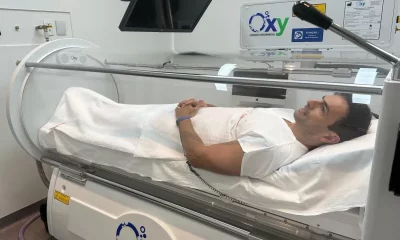
Analysis | The Callisto Protocol gets the setting right, but lacks in gameplay
Follow Us @
The Callisto Protocol
terror prison
Striking Distance Studios bet on mystery to drive the narrative of its first game. With lush graphics, we are immediately thrown into the space conflict that carries the plot. In control of Jacob Lee, pilot of a cargo ship played by star Josh Duhamel, we see our vessel invaded by Dani Nakamura, a mysterious character played by Karen Fukuhara, famous for her role as Kimiko in the series The Boys. After several explosions generated by the collision, in a very well produced sequence, we finally fall on Callisto, the satellite of Jupiter where the action unfolds. Jacob loses his crew in the crash and is arrested by the local police immediately after a mysterious call to the officer searching for the downed ship. Taken to a maximum security prison, he lives the worst nightmares of his life as he tries to figure out why he was imprisoned, what gave rise to the monsters that appeared in the prison, more about the past of human colonization, and bizarre groups. The narrative is not the strong point of the game and, apart from shy appearances of one or another secondary character, it has no outstanding cores. The mystery behind the journey becomes very obvious over time and it doesn’t stray too far from the conventional either. What ends up calling attention is Callisto’s great setting, both inside and outside prison. The talented team at Striking Distance managed to deliver beautiful scenery and lush audio design. If on the one hand the game focuses more on action than on terror, on the other hand it manages to deliver that feeling of constant apprehension thanks to technical realization and good art direction. References to Dead Space are everywhere too. Messages written in blood on the walls, the character’s diegetic interface, weapon customization, camera orientation, almost everything seems to be taken straight from the classic. The amount of blood and violent scenes is also impressive. With each death of Jacob it’s almost like a “Fatality” from Mortal Kombat happens on the screen, with amputations, screams of pain and a lot of blood spurting. Definitely not for those with the weakest of stomachs. On PS5, where we played, the game’s performance is exemplary and the use of the platform is well executed, including secondary elements such as the good implementation of DualSense. On other platforms, however, there are a lot of issues at the moment, especially on PC. If you intend to take a chance on any of them, it’s good to read the reports of other players before making the decision to disburse the salty amount for the game now at launch.Repetitive gameplay and confusing design
Setting is not everything and, especially in a game with such a strong focus on action scenes, gameplay ends up being one of the most important pillars. The team here was bold and focused on melee combat. Jacob, at first, only has improvised weapons and then gets an electrified baton from a guard. To defeat the monsters along the way, he needs to dodge accurately and counterattack with force again and again to kill them. The main obstacle is the controls. The deviation is done with the right analog stick, the same one that moves the camera, which causes a certain discomfort, especially since it is not the standard in other games of the type. It is necessary to alternate between left and right on the stick to continue dodging, which requires some practice time that the game does not provide, since right away it is putting two or more enemies on top of the player. Even after hours of practice, these moves still feel a bit imprecise, especially since they only work from a certain distance and there’s no way to tag an enemy. On final bosses, sometimes I died moving the camera instead of dodging due to not being as close as necessary. After the first few hours, the protagonist gains firearms, but the design as a whole is made so that you always have to resort to hand-to-hand combat, including most of the monsters simply running towards you. There are even combos to hit with the stick and then fire a weapon quickly to remove an enemy limb and win the fight. Betting on this vision transformed the game into a divisive one immediately, but the aggravating thing is to see that sometimes everything is thrown up in key moments. There’s a two-headed monster that kills your character with just one attack, for example. Dodging against him is useless and you only have to resort to firearms, which you probably won’t have improved enough until the end of the game, when he appears, generating dozens of annoying deaths that show the same lengthy animation on the screen. In addition to conflicting gameplay, there are other issues. Enemies are repeated to exhaustion and most of the time it comes down to walking forward and executing them. There are no cool puzzles or interesting exploration elements, just a repetition of ideas that makes the game tired after a few hours. Even the stealth parts didn’t give the necessary freshness to the gameplay and also suffer from simplicity. Perhaps a more robust budget was lacking, something that EA is probably guaranteeing in the remake of the original Dead Space. Speaking of the work that inspires it, The Callisto Protocol ends up lacking much personality, since the little it brings back ends up being more problematic than a great goal as they did in Visceral’s time. In fact, you even miss several things. Weapons, for example, are far from Dead Space’s creativity and fall into the shotgun, air and pistol cliché. In the end, the shadow of Dead Space consumed Callisto like a lunar eclipse and the result is not convincing.Conclusion
The Callisto Protocol gets the setting right and delivers lush graphics on the new generation, but it doesn’t go beyond that. Design decisions for the gameplay are conflicting and lead to over-the-top repetition with frustration over the exotic controls. In the end, he fails to reach the work that inspires him and also does not bring anything very relevant to the genre. pros- Stunning graphics, especially where the characters are concerned
- Death animations are varied and fun
- Setting and sound design convince and frighten
- Unresponsive and confusing gameplay
- Enemies without variety are repeated to exhaustion
- Exaggerated focus on combat, which is not the best
- Little variation in goals
A PS5 copy of the game was provided by Krafton for the preparation of this review.
Follow AFRILATEST on Google News and receive alerts for the main news about celebrities, soap operas, series, entertainment and more!
SHARE POST AND EARN REWARDS:
Join our Audience reward campaign and make money reading articles, shares, likes and comment >> Join reward Program
FIRST TIME REACTIONS:
Be the first to leave us a comment, down the comment section. click allow to follow this topic and get firsthand daily updates.
JOIN US ON OUR SOCIAL MEDIA: << FACEBOOK >> | << WHATSAPP >> | << TELEGRAM >> | << TWITTER >
The Callisto Protocol-
Good News TV series2 months ago
Justin Bieber and Hailey go to church using a powerful car
-
News2 months ago
Harry decides to appeal after loss of police protection in the UK
-
Good News TV series2 months ago
Preta Gil is the new presenter of TVZ on Multishow
-
Good News TV series2 months ago
Fuzuê: Pascoal is sentenced to more than 70 years in prison
-
News2 months ago
Viradouro wins the Rio de Janeiro Carnival title in 2024 now news
-
Health and Fitness2 months ago
Hyperbaric Oxygenation accelerates recovery from knee injuries, according to USP study
-
Culture2 months ago
the Sub4 Turismo package that we recommend and we go (on the 42 km)
-
Good News TV series2 months ago
Cris discovers Isis's pregnancy. And now?





























